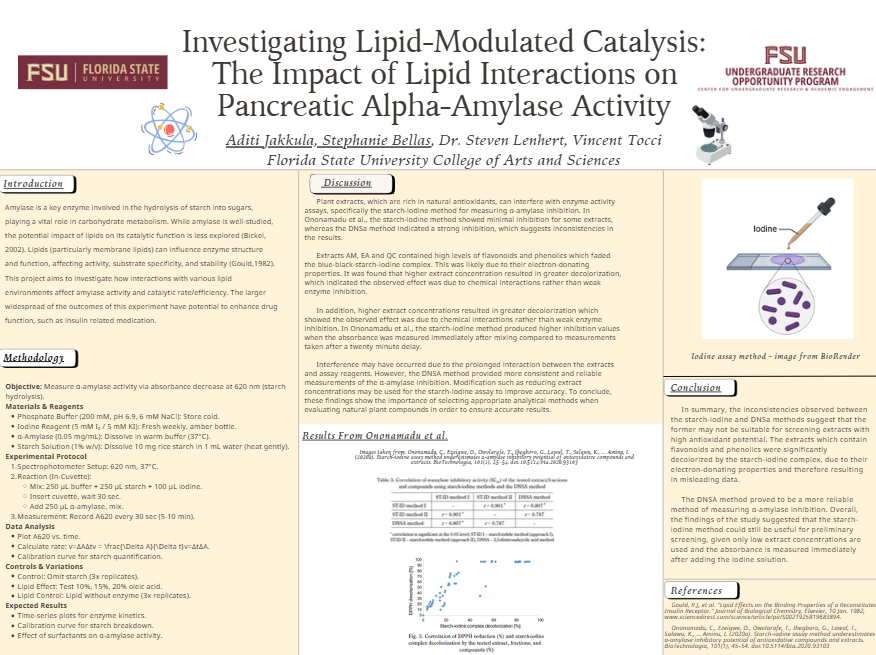Research Symposium
25th annual Undergraduate Research Symposium, April 1, 2025
Aditi Jakkula Poster Session 1: 9:30 am - 10:30 am/ Poster #15

BIO
My name is Aditi Jakkula, and I am currently a second year student at FSU, from Tampa FL. I am majoring in Biological sciences, on a pre-dental track, with the ultimate goal of pursuing a career in the dental field. My main area of interest in the research field is exploring enzyme function and catalysis rates based on interaction with other molecules, with the potential to enhance drug function and better the efficiency of antibiotics as a further application.
Investigating Lipid-Modulated Catalysis: The Impact of Lipid Interactions on Pancreatic Alpha-Amylase Activity
Authors: Aditi Jakkula, Steven LenhertStudent Major: Biological Sciences
Mentor: Steven Lenhert
Mentor's Department: Biological Sciences Mentor's College: College of Arts and Sciences Co-Presenters: Stephanie Bellas
Abstract
The goal of this research is to investigate the influence of lipid interactions on pancreatic alpha-amylase catalysis with a starch-iodine assay. This investigation is integral to understanding the role of lipids in enzyme activity, specifically how lipids impact the function and catalytic rate of pancreatic alpha-amylase. Triplicates of test tubes with different lipid concentrations were created, as well as a control test tube with amylase and no lipid. The experimental tube had amylose, lipid, and buffer. The assays were then run, and the indicator displayed a blue color (for absorbance). Absorbance is measured by indicator color, and then data was analyzed based on rate of absorbance and absorbance level. Because of the amphipathic state of lipids, it is made susceptible to interactions with other molecules, which is what leads to the interaction with enzymes.The results of the experiment are expected to show enhanced function/ increased enzyme catalysis rate with lipid interactions introduced. The study by Ononamadu et al explores the effectiveness of two different assay methods to measure enzyme catalysis rate. Ultimately, there were inconsistencies observed between the starch-iodine and DNSa methods, which suggest that the former may not be suitable for screening extracts with high antioxidant potential. The results display that lipids have the potential to alter/enhance the function of certain drugs and antibiotics, using the better-suited DNS assay method as a catalysis measuring method. A further application of this study could be especially promising in the field of antibiotic enhancement, given that the DNS assay method is used.
Keywords: Lipid-Catalysis, Alpha amylase, Interactions


